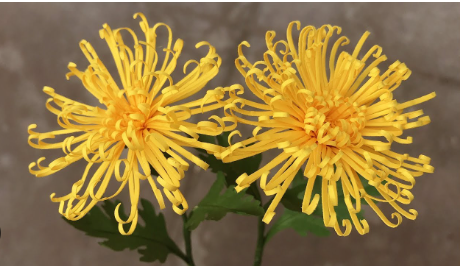
Chrysanthemums have a long history and are native to Asia, particularly China and Japan. They were first cultivated in China over 2000 years ago. They were introduced to Europe in the 17th century, where for years they have been popular among gardeners. Today, are grown all over the world.
Spider mums are part of the daisy family of plants, which also includes zinnias and marigolds. This chrysanthemum, also known as the Fuji Mum or Dendranthema x grandiflorum is commonly used in floral arrangements, bouquets and can be grown in pots for easy display indoors. Like other chrysanthemums, spider mums bloom late in the season blooms, that is from late summer to early autumn.
Spider mum blooms can be quite large, with a diameter ranging from 2 to 4 inches. The petals are long, narrow strands that cover the entire face of the flower. The drooping legs resemble spider legs. These petals can be thin and wiry or thick and substantial. The petals can also be straight or slightly curved at the tips. The flowers can be in a rainbow of colors, from classic whites and yellows to more daring shades like purple, bright pink, bronze, and apricot.
The ‘Anastasia Flower,’ for example, is a variety of spider mum that grows large flower heads that can top 4 inches across. Other varieties include the ‘Yellow Rayonnante’ and ‘Magdalena’ spider mums, which produce smaller flowers. Typically, spider mums that are cut for floral arrangements will stay fresh for up to 14 days.
In the garden, spider chrysanthemums can grow up to 36 inches tall and 4 feet wide. They are particularly well-suited for planting in full sun or partial shade, and they prefer slightly acidic soil with a pH of about 6.5. These flowers are hardy and can survive winters down to Zone 5. They are suitable for a wide range of climates.
Characteristic of Spider Chrysanthemum
- Habit: Herbaceous perennial with an upright growth habit with sturdy stems that support their large, intricate blooms.
- Height: They grow between 3 to 5 feet tall.
- Moderate to Fast: They have a moderate to fast growth rate, particularly when provided with optimal growing conditions.
- Lifespan: They are perennials, they live for more than two years.
- Leaves: Finely divided, fern-like leaves in a deep green color. Leaves are alternately arranged along the stems.
- Flower: The flowers have long, thin, tubular petals that spread outwards in various directions, resembling spider legs. These petals can be straight, hooked, or curved.
- Size: The blooms can be quite large, often measuring 4 to 6 inches in diameter, and sometimes even larger.
- Bloom Time: They bloom in the late fall, extending the flowering season when many other plants have finished blooming.
- Stems: The stems are erect, sturdy. They have a somewhat rough texture and can be slightly hairy.
- Root System: Has a fibrous root system. The roots are relatively shallow, spreading out in the top few inches of soil.
- USDA zones: They thrive in USDA zones 4-8. They are moderately cold-tolerant but may need winter protection in colder zones. They can be grown as annuals in cooler zones.
Cultivation of Spider Chrysanthemum
Planting
- Timing: Plant spider mums in the spring after the danger of frost has passed. You can also plant them in fall in warmer climates (zones 7-8) but ensure they’re established before a hard freeze.
- Location: Choose a location that receives full sun for at least 6 hours a day. This is crucial for encouraging abundant blooms.
- Soil: Prepare well-draining soil rich in organic matter. Amending your planting bed with compost or aged manure is beneficial.
- Planting depth and spacing: Dig holes slightly deeper than the root ball of your plant. Space them 12-18 inches apart to allow for good air circulation and future growth.
Care
- Watering: Water regularly during the growing season, especially during hot and dry periods. Aim to keep the soil consistently moist but not soggy. Spider mums can tolerate periods of slight drought, but prolonged dryness can affect flower production.
- Fertilizing: Feed your spider mums with a balanced fertilizer every 4-6 weeks during the growing season. Stop fertilizing in late summer to encourage healthy bud formation and vibrant blooms.
- Pinch Back: To encourage bushier growth and more blooms, pinch back the tips of the stems when the plants are about 6 inches tall. Repeat this process every time the plants grow another 6 inches.
- Support Tall Stems: Some varieties of spider mums can grow quite tall, so it’s a good idea to provide support for the stems. This can be done with stakes or a trellis.
- Deadhead Spent Blooms: To keep your spider mums blooming for as long as possible, be sure to deadhead spent blooms. This means removing the flowers as soon as they start to fade.
- Winter Care: In colder climates, spider mums may need some extra care to survive the winter. After the first frost, cut the stems back to about 10 inches above the ground. Then, cover the plants with a layer of mulch to help insulate the roots.
- Dividing: Every 3-4 years, you can divide your spider mums to maintain healthy growth and prevent overcrowding. Do this in early spring before new growth emerges.
- Pests and diseases: Spider mums are generally pest and disease resistant. However, keep an eye out for common garden problems like aphids, spider mites, and powdery mildew.